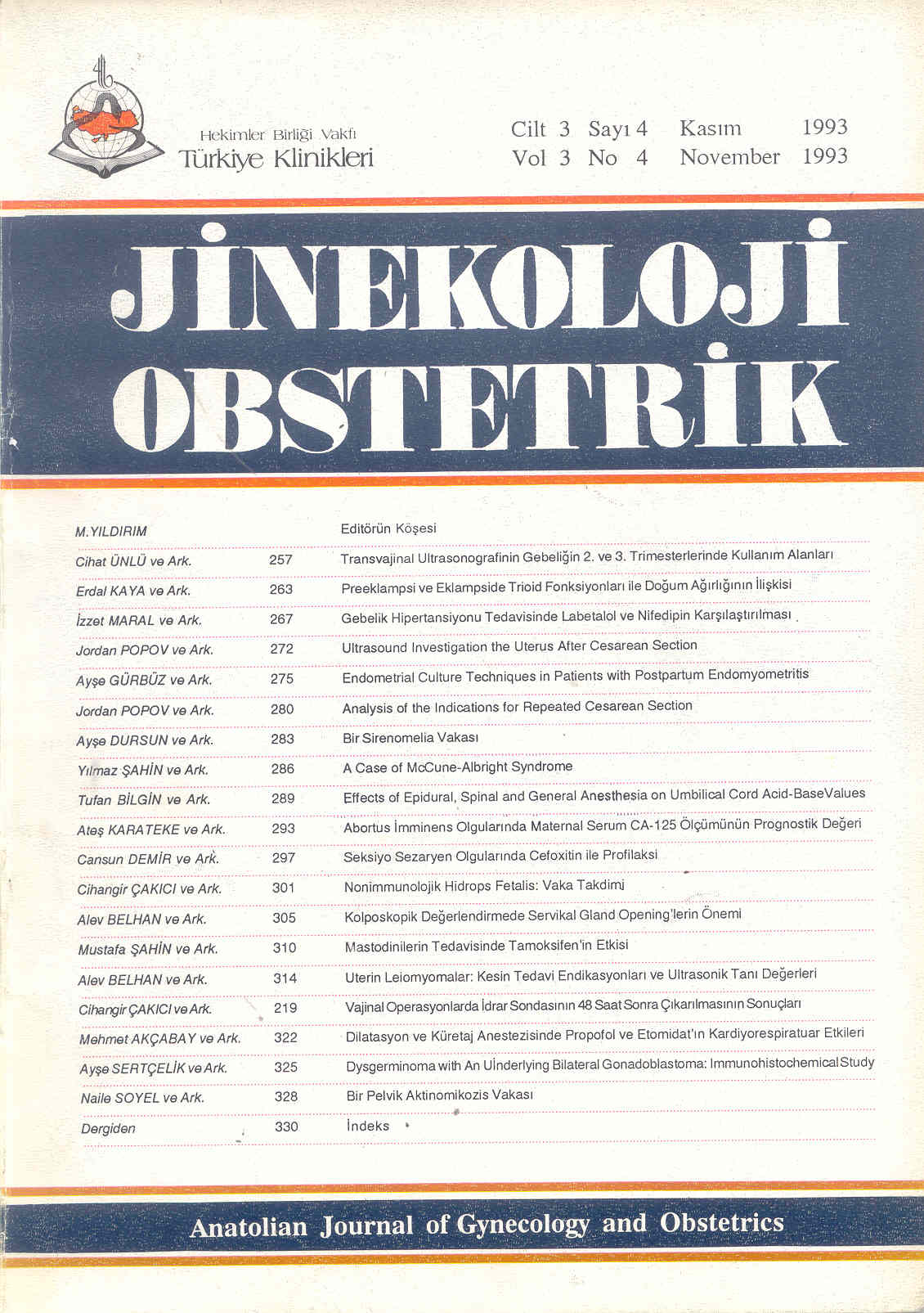Open Access
Peer Reviewed
ARTICLES
3238 Viewed1021 Downloaded
Effects of Epidural, Spinal and General Anesthesia on Umbilical Cord Acid-Base Values
Epidural Spinal Ve Genel Anestezinin Umbilikal Kord Asit Baz Dengesine Etkisi
Turkiye Klinikleri J Gynecol Obst. 1993;3(4):289-92
Article Language: TR
Copyright Ⓒ 2025 by Türkiye Klinikleri. This is an open access article under the CC BY-NC-ND license (http://creativecommons.org/licenses/by-nc-nd/4.0/)
ÖZET
Değişik anestezi tiplerinin umbilikal kord asit baz dengesine etkisi 70 elektif sezaryen olgusunda çalışıldı. Olguların 18'ine epidural, 25'ine spinal ve 27'sine genel anestezi uygulandı. Epidural anestezi için epidural aralığa %0.5 bupivakain 60-75 mg, spinal anestezi için subaraknoid aralığa %0.5 bupivakain heavy 7.5-10 mg verildi. İğne ucuyla anestezi düzeyi kontrol edildikten sonra operasyona başlandı. Genel anestezi için 5-6 mg sodyum thiopental ile indüksiyondan sonra 1.5 mg/kg süksinilkolinle entübasyon yapılıp operasyona geçildi. Kordon klempe edildikten hemen sonra heparinize enjektörlere ayrı ayrı umbilikal ven ve arterden kan örneği alınarak pH, pO2, pCO2, HCO3 ve baz fazlalığı çalışıldı. Umbilikal arter ortalama pH'ı epidural spinal ve genel anestezi için sırasıyla 7.30-0.3, 7.31-0.06, 7.32-0.04 olarak bulundu (p< 0.05). Gruplar arasında Apgar skoru, umbilikal arter ve venöz kan gazları açısından istatistiki anlam saptanamadı. Bu bulgular sezaryende anestezi türünün önceden deprese olmayan term fetusta birbirine karşı kesin bir üstünlüğü olmadığını göstermektedir.
Değişik anestezi tiplerinin umbilikal kord asit baz dengesine etkisi 70 elektif sezaryen olgusunda çalışıldı. Olguların 18'ine epidural, 25'ine spinal ve 27'sine genel anestezi uygulandı. Epidural anestezi için epidural aralığa %0.5 bupivakain 60-75 mg, spinal anestezi için subaraknoid aralığa %0.5 bupivakain heavy 7.5-10 mg verildi. İğne ucuyla anestezi düzeyi kontrol edildikten sonra operasyona başlandı. Genel anestezi için 5-6 mg sodyum thiopental ile indüksiyondan sonra 1.5 mg/kg süksinilkolinle entübasyon yapılıp operasyona geçildi. Kordon klempe edildikten hemen sonra heparinize enjektörlere ayrı ayrı umbilikal ven ve arterden kan örneği alınarak pH, pO2, pCO2, HCO3 ve baz fazlalığı çalışıldı. Umbilikal arter ortalama pH'ı epidural spinal ve genel anestezi için sırasıyla 7.30-0.3, 7.31-0.06, 7.32-0.04 olarak bulundu (p< 0.05). Gruplar arasında Apgar skoru, umbilikal arter ve venöz kan gazları açısından istatistiki anlam saptanamadı. Bu bulgular sezaryende anestezi türünün önceden deprese olmayan term fetusta birbirine karşı kesin bir üstünlüğü olmadığını göstermektedir.
ANAHTAR KELİMELER: Sezaryen, genel anestezi, rejional anestezi
ABSTRACT
Effects of different types of anesthesia on umbilical cord acid-base values were studied on 70 elective cesarean sections. 60-75 mg 0.5% bupivacaine was administered to the epidural space in 18 patients. 7.5-10 mg 0.5% bupivacaine heavy was administered to the subarachnoid space in 25 patients. Operation was started after the level of anesthesia was controlled by a needle. For general anesthesia in 27 patients, anesthesia was induced with 5-6 mg/kg sodium thiopental IV. operation was started immediately after the intubation was achieved with 1.5 mg/kg succinylcholine IV. blood samples were taken into heparinized syringes from umbilical artery and vein separately, immediately after clamping the cord. Umbilical arterial and venous pH, pO2, PCO2, base excess were determined. Mean umbilical artery pH values were 7.30-0.3, 7.31-0.06, 7.32-0.04 for epidural, spinal and general anesthesia respectively (p< 0.05). Mean apgar scores, umbilical arterial and venous blood gases were not statistically significant between the groups. Anesthesia type for cesarean section in the nondepressed, term fetus is not superior to each other according to these results.
Effects of different types of anesthesia on umbilical cord acid-base values were studied on 70 elective cesarean sections. 60-75 mg 0.5% bupivacaine was administered to the epidural space in 18 patients. 7.5-10 mg 0.5% bupivacaine heavy was administered to the subarachnoid space in 25 patients. Operation was started after the level of anesthesia was controlled by a needle. For general anesthesia in 27 patients, anesthesia was induced with 5-6 mg/kg sodium thiopental IV. operation was started immediately after the intubation was achieved with 1.5 mg/kg succinylcholine IV. blood samples were taken into heparinized syringes from umbilical artery and vein separately, immediately after clamping the cord. Umbilical arterial and venous pH, pO2, PCO2, base excess were determined. Mean umbilical artery pH values were 7.30-0.3, 7.31-0.06, 7.32-0.04 for epidural, spinal and general anesthesia respectively (p< 0.05). Mean apgar scores, umbilical arterial and venous blood gases were not statistically significant between the groups. Anesthesia type for cesarean section in the nondepressed, term fetus is not superior to each other according to these results.
MENU
POPULAR ARTICLES
MOST DOWNLOADED ARTICLES





This journal is licensed under a Creative Commons Attribution-NonCommercial-NoDerivatives 4.0 International License.










